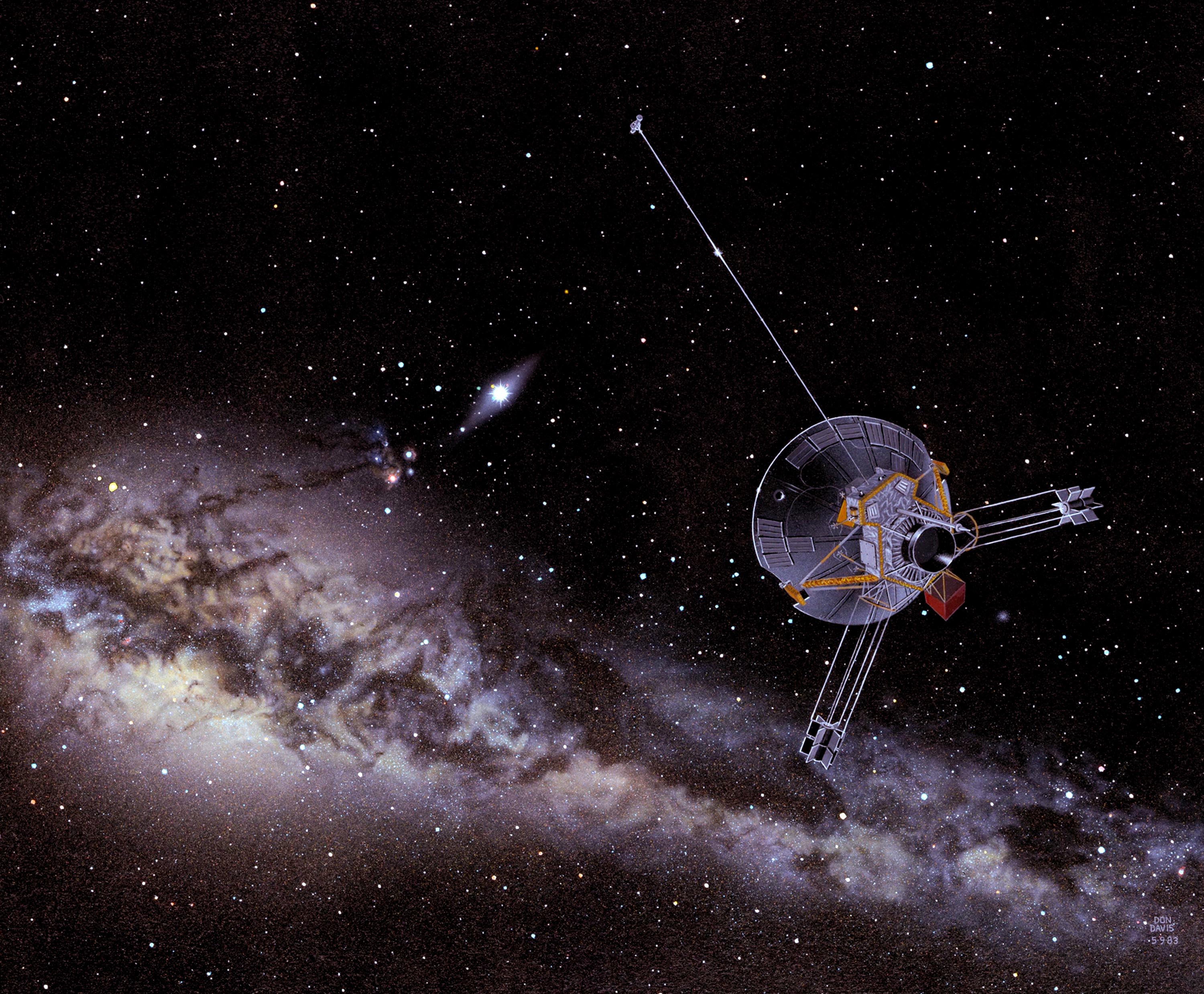10 Inexplicable Phenomena That Still Make No Sense To Us
Mizuka Ishiwatari
Published
05/23/2015
Despite the progress of science, humans are still unable to explain any of these.
- List View
- Player View
- Grid View
Advertisement
-
1.
 The Kuiper cliff - If you travel out to the far edge of the solar system, into the frigid wastes beyond Pluto, you'll see something strange. Suddenly, after passing through the Kuiper belt, a region of space teeming with icy rocks, there's no sign of anything. Something must have swept it - probably an invisible planet or another object, which cleared the debris surrounding it. The phenomenon is called Planet X, and we still don't know what hides behind the Kuiper Cliff.
The Kuiper cliff - If you travel out to the far edge of the solar system, into the frigid wastes beyond Pluto, you'll see something strange. Suddenly, after passing through the Kuiper belt, a region of space teeming with icy rocks, there's no sign of anything. Something must have swept it - probably an invisible planet or another object, which cleared the debris surrounding it. The phenomenon is called Planet X, and we still don't know what hides behind the Kuiper Cliff. -
2.
 The placebo effect - Several times a day, for several days, you induce pain in someone. You control the pain with morphine until the final day of the experiment, when you replace the morphine with saline solution. The saline takes the pain away. When Fabrizio Benedetti of the University of Turin in Italy carried out the above experiment, and added naloxone, a drug that blocks the effects of morphine, to the saline. The pain-relieving power of saline solution disappeared. Benedetti says, that one thing is clear: the mind can affect the body's biochemistry.
The placebo effect - Several times a day, for several days, you induce pain in someone. You control the pain with morphine until the final day of the experiment, when you replace the morphine with saline solution. The saline takes the pain away. When Fabrizio Benedetti of the University of Turin in Italy carried out the above experiment, and added naloxone, a drug that blocks the effects of morphine, to the saline. The pain-relieving power of saline solution disappeared. Benedetti says, that one thing is clear: the mind can affect the body's biochemistry. -
3.
 The horizon problem - Look across space from one edge of the visible universe to the other, and you'll see that the microwave background radiation filling the cosmos is at the same temperature everywhere. That may not seem surprising until you consider that the two edges are nearly 28 billion light years apart and our universe is only 14 billion years old. Nothing can travel faster than the speed of light, so there is no way heat radiation could have travelled between the two horizons to even out the hot and cold spots created in the big bang and leave the thermal equilibrium we see now.
The horizon problem - Look across space from one edge of the visible universe to the other, and you'll see that the microwave background radiation filling the cosmos is at the same temperature everywhere. That may not seem surprising until you consider that the two edges are nearly 28 billion light years apart and our universe is only 14 billion years old. Nothing can travel faster than the speed of light, so there is no way heat radiation could have travelled between the two horizons to even out the hot and cold spots created in the big bang and leave the thermal equilibrium we see now. -
4.
 The Sixth Sense - The five senses of sight, hearing, taste, touch, and smell help us explore our physical world. There is also a sixth sense, an inner power of perception known as intuition. A study published in Current Biology also found that participants, who had to choose instantly, and having to rely on intuition, were more accurate in picking out an odd symbol among over 650 identical ones than when given 1.5 seconds to look at the symbols.
The Sixth Sense - The five senses of sight, hearing, taste, touch, and smell help us explore our physical world. There is also a sixth sense, an inner power of perception known as intuition. A study published in Current Biology also found that participants, who had to choose instantly, and having to rely on intuition, were more accurate in picking out an odd symbol among over 650 identical ones than when given 1.5 seconds to look at the symbols. -
5.
 Ultra-energetic cosmic rays - For more than a decade, physicists in Japan have been seeing cosmic rays that should not exist. Cosmic rays are particles - mostly protons but sometimes heavy atomic nuclei - that travel through the universe at close to the speed of light. Some cosmic rays detected on Earth are produced in violent events such as supernovae, but we still don't know the origins of the highest-energy particles, which are the most energetic particles ever seen in nature. As cosmic-ray particles travel through space, they lose energy in collisions with the low-energy photons that pervade the universe, such as those of the cosmic microwave background radiation. Japasnese scientists have detected several cosmic rays above the GZK limit. In theory, they can only have come from within our galaxy, avoiding an energy-sapping journey across the cosmos. However, astronomers can find no source for these cosmic rays in our galaxy. Where did they come from then?
Ultra-energetic cosmic rays - For more than a decade, physicists in Japan have been seeing cosmic rays that should not exist. Cosmic rays are particles - mostly protons but sometimes heavy atomic nuclei - that travel through the universe at close to the speed of light. Some cosmic rays detected on Earth are produced in violent events such as supernovae, but we still don't know the origins of the highest-energy particles, which are the most energetic particles ever seen in nature. As cosmic-ray particles travel through space, they lose energy in collisions with the low-energy photons that pervade the universe, such as those of the cosmic microwave background radiation. Japasnese scientists have detected several cosmic rays above the GZK limit. In theory, they can only have come from within our galaxy, avoiding an energy-sapping journey across the cosmos. However, astronomers can find no source for these cosmic rays in our galaxy. Where did they come from then? -
6.
 Dark matter - Although researchers have made many suggestions about what kind of particles might make up dark matter, there is no consensus. It's an embarrassing hole in our understanding. Astronomical observations suggest that dark matter must make up about 90 per cent of the mass in the universe, yet we are astonishingly ignorant what that 90 per cent is.
Dark matter - Although researchers have made many suggestions about what kind of particles might make up dark matter, there is no consensus. It's an embarrassing hole in our understanding. Astronomical observations suggest that dark matter must make up about 90 per cent of the mass in the universe, yet we are astonishingly ignorant what that 90 per cent is. -
7.
 Viking's methane - JULY 20, 1976, Mars. The Viking landers have scooped up some soil and mixed it with carbon-14-labelled nutrients and detect emissions of carbon-14-containing methane from the soil. There must be life on Mars. Something is ingesting the nutrients, metabolising them, and then belching out gas laced with carbon-14. Furthermore, the results from NASA's latest rovers show that the surface of Mars was almost certainly wet in the past and therefore hospitable to life. Despite that, no trace of life has been found on Mars so far.
Viking's methane - JULY 20, 1976, Mars. The Viking landers have scooped up some soil and mixed it with carbon-14-labelled nutrients and detect emissions of carbon-14-containing methane from the soil. There must be life on Mars. Something is ingesting the nutrients, metabolising them, and then belching out gas laced with carbon-14. Furthermore, the results from NASA's latest rovers show that the surface of Mars was almost certainly wet in the past and therefore hospitable to life. Despite that, no trace of life has been found on Mars so far. -
Advertisement
-
8.
 Tetraneutrons - A particle accelerator in France detected six particles that should not exist. They are called tetraneutrons: four neutrons that are bound together in a way that defies the laws of physics.
Tetraneutrons - A particle accelerator in France detected six particles that should not exist. They are called tetraneutrons: four neutrons that are bound together in a way that defies the laws of physics. -
9.
 The Pioneer anomaly - Pioneer 10 was launched in 1972; Pioneer 11 a year later. By now both craft should be drifting off into deep space with no one watching. However, their trajectories have proved far too fascinating to ignore. Something has been pulling - or pushing - on them, causing them to speed up, enough to have shifted Pioneer 10 some 400,000 kilometres off track, before NASA lost contact with it. Same happened to Pioneer 11.
The Pioneer anomaly - Pioneer 10 was launched in 1972; Pioneer 11 a year later. By now both craft should be drifting off into deep space with no one watching. However, their trajectories have proved far too fascinating to ignore. Something has been pulling - or pushing - on them, causing them to speed up, enough to have shifted Pioneer 10 some 400,000 kilometres off track, before NASA lost contact with it. Same happened to Pioneer 11. -
10.
 The Wow signal - It was 37 seconds long and came from outer space. On 15 August 1977 it caused astronomer Jerry Ehman, then of Ohio State University in Columbus, to scrawl "Wow!" on the printout from Big Ear, Ohio State's radio telescope in Delaware. No one knows what created the signal. Coming from the direction of Sagittarius, the pulse of radiation was confined to a narrow range of radio frequencies around 1420 megahertz. This frequency is in a part of the radio spectrum in which all transmissions are prohibited by international agreement. The nearest star in that direction is 220 light years away. If that is where is came from, an advanced alien civilisation might have used an astonishingly large and powerful transmitter to contact us.
The Wow signal - It was 37 seconds long and came from outer space. On 15 August 1977 it caused astronomer Jerry Ehman, then of Ohio State University in Columbus, to scrawl "Wow!" on the printout from Big Ear, Ohio State's radio telescope in Delaware. No one knows what created the signal. Coming from the direction of Sagittarius, the pulse of radiation was confined to a narrow range of radio frequencies around 1420 megahertz. This frequency is in a part of the radio spectrum in which all transmissions are prohibited by international agreement. The nearest star in that direction is 220 light years away. If that is where is came from, an advanced alien civilisation might have used an astonishingly large and powerful transmitter to contact us.
- NEXT GALLERY
-

- 29 Funny Trump And Kim Memes
The Kuiper cliff - If you travel out to the far edge of the solar system, into the frigid wastes beyond Pluto, you'll see something strange. Suddenly, after passing through the Kuiper belt, a region of space teeming with icy rocks, there's no sign of anything. Something must have swept it - probably an invisible planet or another object, which cleared the debris surrounding it. The phenomenon is called Planet X, and we still don't know what hides behind the Kuiper Cliff.
10/10
1/10
SOURCE:NEW SCIENTIST








54 Comments